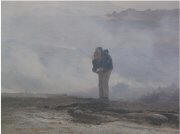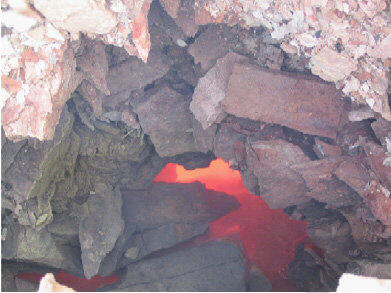Underground Coal Fires
J.R. Hehnly
January 31, 2007

Smoke seeps from the ground
above an underground coal fire.
I was talking about global warming with Gabe Garfield the other day and had some random memory of having read that there were underground coal fires in China putting out more carbon dioxide than all the cars in the United States. At the time I wasn’t sure if it was a real memory or just something my mind made up. I later did a quick Google lookup and did in fact find references to the coal fires. Assuming that these fires could be a considerable contributor to CO2 concentrations I wondered if the experts counted the contributions as natural or man-made. So I walked down to the office of OU’s climate expert and IPCC member to ask about it. I was surprised to find out that he was not familiar with these underground coal fires. I’d have to answer my own questions on the subject.
After some additional web searches I found that these underground coal fires are not uncommon around the world. There have been a few magazine articles and web publications on the topic and at least one journal article on the environmental impacts of the fires in China (http://www.ipf.tuwien.ac.at/publications/2007/kuenzer_etal07_coalfires_applied_geography.pdf). It is estimated that 15-20 million tons of coal burn there every year. The paper gives an annual CO2 equivalent emission by the fires of 54,740,000 tons, counting 1 ton of methane release as 23 tons of CO2 equivalence. This equals 49.66 teragrams, far less than the 630+ teragrams from U.S. automobile emissions. And tiny compared to the total of 6000+ teragrams the U.S. produces per year. (Figures from http://www.epa.gov/climatechange/emissions/downloads06/06Energy.pdf)
An Australian Broadcasting Corporation site claims the amount of coal buring per year in the China fires is 200 million tons (http://www.abc.net.au/science/news/enviro/EnviroRepublish_786127.htm). This would bring the CO2 output very close to the US automobile output. The site also talks about Australia being the home of one of the world's few naturally burning coal seams, Burning Mountain Nature Reserve, in northeastern New South Wales. The fire burns 30 meters underground, moving at the slow rate of one meter south every year. The lack of oxygen underground means the fire burns slowly, and with 6 km of burnt area, the fire is estimated to be about 5,500 years old.

Coal burning in a surface fissure.
I did find some interesting reading about a town in Pennsylvania that has been largely abandoned since a fire was accidentally started there in 1962 (http://www.offroaders.com/album/centralia/centralia.htm). The fire still burns and it is estimated to have 400 years of fuel left. There are over 45 fires burning in Pennsylvania. The site references a paper stating it would cost $600+ million to extinguish the fires in the U.S.
I’d be interested if anyone reading this has studied these fires or has any input as to how much impact the fires worldwide would have on CO2 levels.